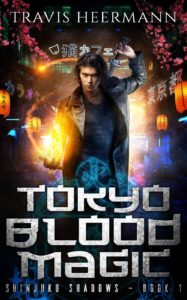Cooking with Cat:
Steamed Pork Buns are the Food of the Gods
by Travis Heermann
Back when I was living in Japan, about 2003-2006, one of the foods that I fell in love with was nikuman 肉ã¾ã‚“, steamed pork buns. They could be found in any convenience store, and they made a great meal for someone who didn’t feel like cooking.
 They come with various fillings: pork, beef, chicken, shrimp, veggie, even sweet custard. They are particularly comforting when the weather turns chilly and they’re all steamy and warm.
They come with various fillings: pork, beef, chicken, shrimp, veggie, even sweet custard. They are particularly comforting when the weather turns chilly and they’re all steamy and warm.
I was planning a vacation to Japan with the family in March 2020. We’d been planning it for years, and it would have been the first time I’d been back since returning to the States. I was excited to show my family, whom I didn’t have then, all the sights.
A secondary reason for going to Japan was professional, as I was in the midst of writing Tokyo Blood Magic, the first volume of my Shinjuku Shadows trilogy. I wanted to visit some important Tokyo locales, refresh my memory, gather some inspiration, but it was not to be.
As you might guess, COVID-19 derailed that, four days before wheels up for Tokyo. I was crushed, and nine months of isolation has not done much to help that state of mind.
Nevertheless, writing the book did assuage some of my disappointment, as I spent a lot of time in Google Street View, walking virtually around the streets of Tokyo. Writing the book was a fun way to reminisce, and also learn about places I didn’t get to visit while I was living there, such as Shizuoka, Ginza, and Roppongi.
There’s a scene in Tokyo Blood Magic where our hero, Django Wong, a ninja warlock, has his bacon saved from a very dangerous monster by a wisecracking alley cat, known only as Cat. Cat, however, is far from normal, and it’s not clear exactly what he is until Book 2, Tokyo Monster Mash.
Amid snarky repartee, Django and Cat venture into a convenience store for some post-fracas grub, where nikuman becomes a big part of their bonding. Cat becomes Django’s supernatural sidekick.
So in this Year of a Thousand Cuts, I wanted some comfort food for the Virtual Book Launch Party, which my wife and I put together over Zoom a couple of weeks after Tokyo Blood Magic was released. So I made some nikuman, and this video tells the tale so much better than text.
This recipe is adapted from Japanese measurements. Credit for the original goes to Namiko Chen.
Nikuman, Steamed Pork Buns
Video:Â Cooking With Cat – Nikuman
INGREDIENTS
DOUGH
- 2 1/3 cups all-purpose white flour, plus more for dusting
- 2 scant Tbsp sugar
- 1/2 tsp salt
- 1 tsp baking powder
- 1 tsp instant yeast
- 1 Tbsp neutral-flavored oil (vegetable, canola, etc.)
- 2/3 to 3/4 cup water
FILLING
- 2 shiitake mushrooms (without the stems), finely chopped
- 1/2 cup water
- 1 green onion/scallion, finely chopped
- 4 leaves cabbage, finely chopped
- 1 tsp kosher/sea salt
- 3/4 lb. ground pork
- About 1 Tbsp grated fresh ginger
- 1 tsp sugar
- 1 Tbsp sake
- 1 Tbsp soy sauce
- 1 Tbsp toasted sesame oil
- 1 Tbsp potato starch/cornstarch
- freshly ground black pepper
INSTRUCTIONS
- First, we make the dough. Put all dry ingredients in a large bowl (flour, sugar, salt, baking powder, yeast). Add oil and mix. Once the oil is thoroughly mixed in, slowly add the water while mixing. Mix until incorporated.
- Flour your hands and knead the dough into a ball. If the dough is too dry, add a tablespoon or two of water.
- Sprinkle a smooth surface with flour, move the dough onto the surface, and knead for 10-15 minutes. If the dough is too sticky, sprinkle it with a little flour. After 10-15 minutes, dough should be smooth and silky.
- Form the dough into a ball. Grease the bottom of the bowl with neutral flavored oil and put the dough in the bowl. Cover with plastic wrap and put it in a warm place to rise for about an hour, until the dough doubles in size.
- Meanwhile, it’s time to make the filling. Remove the thick stem parts of the cabbage leaves, then chop them finely. Sprinkle 1 tsp of salt onto the chopped cabbage. Massage the salt into the cabbage. This will begin to draw out cabbage’s moisture. After about ten minutes, squeeze the excess moisture out of the cabbage.
- Add pork, mushrooms, and scallions to another bowl.
- Squeeze the excess moisture from the chopped cabbage, then add it to the pork mixture.
- Add ginger, sugar, sake, soy sauce, toasted sesame oil, and starch. Sprinkle on some fresh black pepper to taste. Mix well. Cover and refrigerate until dough is ready.
- When dough has finished rising, divide the ball in half. Roll each half into a log shape, then cut each log into five pieces. Then cut each piece in half.
Note: If you like big buns, and you cannot lie, you can cut your dough into larger sizes and use more filling for each one.
- Lightly dust the balls with flour, cover them loosely with a damp cloth, and let them rest for ten minutes. (In the video, I missed this step!)
- Roll each ball into a flat circle about five inches in diameter.
- Cut twenty squares of parchment paper, about 3″ x 3″.
- Take a circle of dough and place 1 1/2 Tbsp of filling in the center.
- Fold the dough into a pouch around the filling. It works well to hold the pouch closed with thumb and forefinger while folding up the next bit of dough. First, it will resemble a taco, then a crab rangoon. As you fold in the corners of the “crab rangoon, ,” you’ll end up with a little pouch. Then pinch these corners together and give them a twist to seal the bun. Put each bun on a piece of parchment paper.
- Cover the finished buns with plastic wrap and let them rest for 20 minutes. (In the video, I missed this step, too.)
- Prepare a steamer with boiling water. Put buns in steamer, about 2″ apart. They will swell during steaming process. Steam for 10-15 minutes, (10 for small buns, 15 for large ones).
- Enjoy!
The result: they were delicious.
The texture of the bun was a little bit off, maybe because I missed a couple of steps with letting the dough rest. Another reason might be because I live in the Denver area, and altitude can certainly affect cooking and baking in unexpected ways, which I didn’t account for in my procedure.
Cooking is much like magic and writing. A little here, a little there, bits and pieces of accumulated experience and creative wisdom.
I hope you’ll give this recipe a try for yourself. If you do, let me know how it goes. Going into the Winter of COVID, maybe we’ll all need a little more comfort food.
 Bio:Â Freelance writer, novelist, editor, and screenwriter, Travis Heermann is the author of nine novels, including Tokyo Blood Magic, The Hammer Falls, The Ronin Trilogy, and others, plus short fiction in Apex Magazine, Cemetery Dance, and many more. His freelance work includes contributions to the Firefly Roleplaying Game, Battletech, Legend of Five Rings, and EVE Online.
Bio:Â Freelance writer, novelist, editor, and screenwriter, Travis Heermann is the author of nine novels, including Tokyo Blood Magic, The Hammer Falls, The Ronin Trilogy, and others, plus short fiction in Apex Magazine, Cemetery Dance, and many more. His freelance work includes contributions to the Firefly Roleplaying Game, Battletech, Legend of Five Rings, and EVE Online.
Find out more at travisheermann.com or follow him on Twitter @TravisHeermann.
If you’re an author or other fantasy and science fiction creative, and want to do a guest blog post, please check out the guest blog post guidelines. Or if you’re looking for community from other F&SF writers, sign up for the Rambo Academy for Wayward Writers Critclub!





 I have many thoughts on the GameStop stock/stonk play. Big movements in complex systems are difficult to write about, because many things that seem paradoxical can be correct at the same time. At different scales or frames, differing takes have validity. So forgive what may seem contradictory. For those not familiar with the topic, let’s start with
I have many thoughts on the GameStop stock/stonk play. Big movements in complex systems are difficult to write about, because many things that seem paradoxical can be correct at the same time. At different scales or frames, differing takes have validity. So forgive what may seem contradictory. For those not familiar with the topic, let’s start with  PJ Manney is the author of the P.K. Dick Award-nominated (R)EVOLUTION, book 1 in a series with (ID)ENTITY, and the upcoming trilogy’s completion (CON)SCIENCE, as well as non-fiction and consulting about emerging technology, future humans, and empathy-building through storytelling. She was a former Chairperson of Humanity+, teleplay writer (Hercules–The Legendary Journeys, Xena: Warrior Princess, numerous TV pilot scripts) and film executive.
PJ Manney is the author of the P.K. Dick Award-nominated (R)EVOLUTION, book 1 in a series with (ID)ENTITY, and the upcoming trilogy’s completion (CON)SCIENCE, as well as non-fiction and consulting about emerging technology, future humans, and empathy-building through storytelling. She was a former Chairperson of Humanity+, teleplay writer (Hercules–The Legendary Journeys, Xena: Warrior Princess, numerous TV pilot scripts) and film executive. 